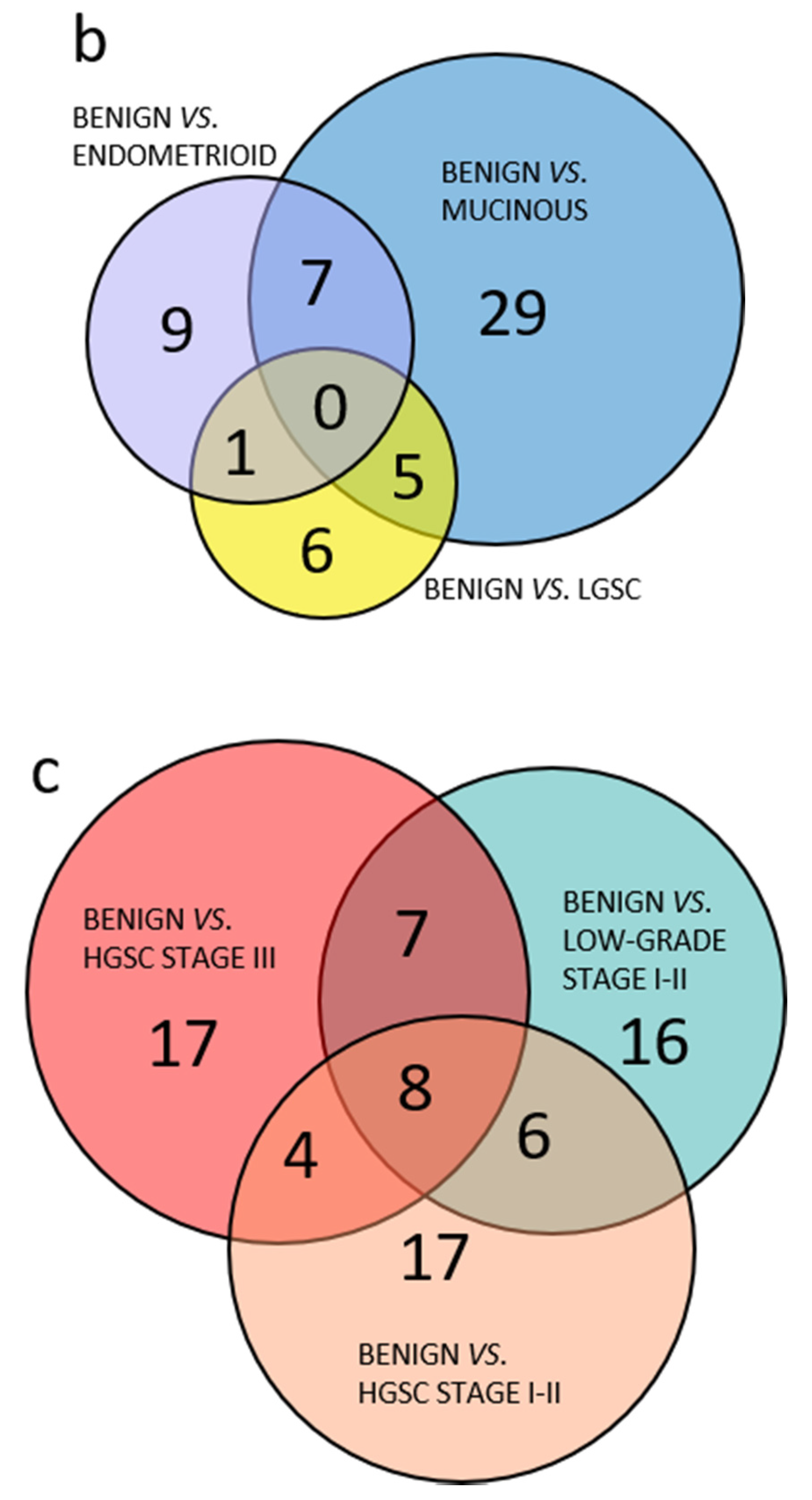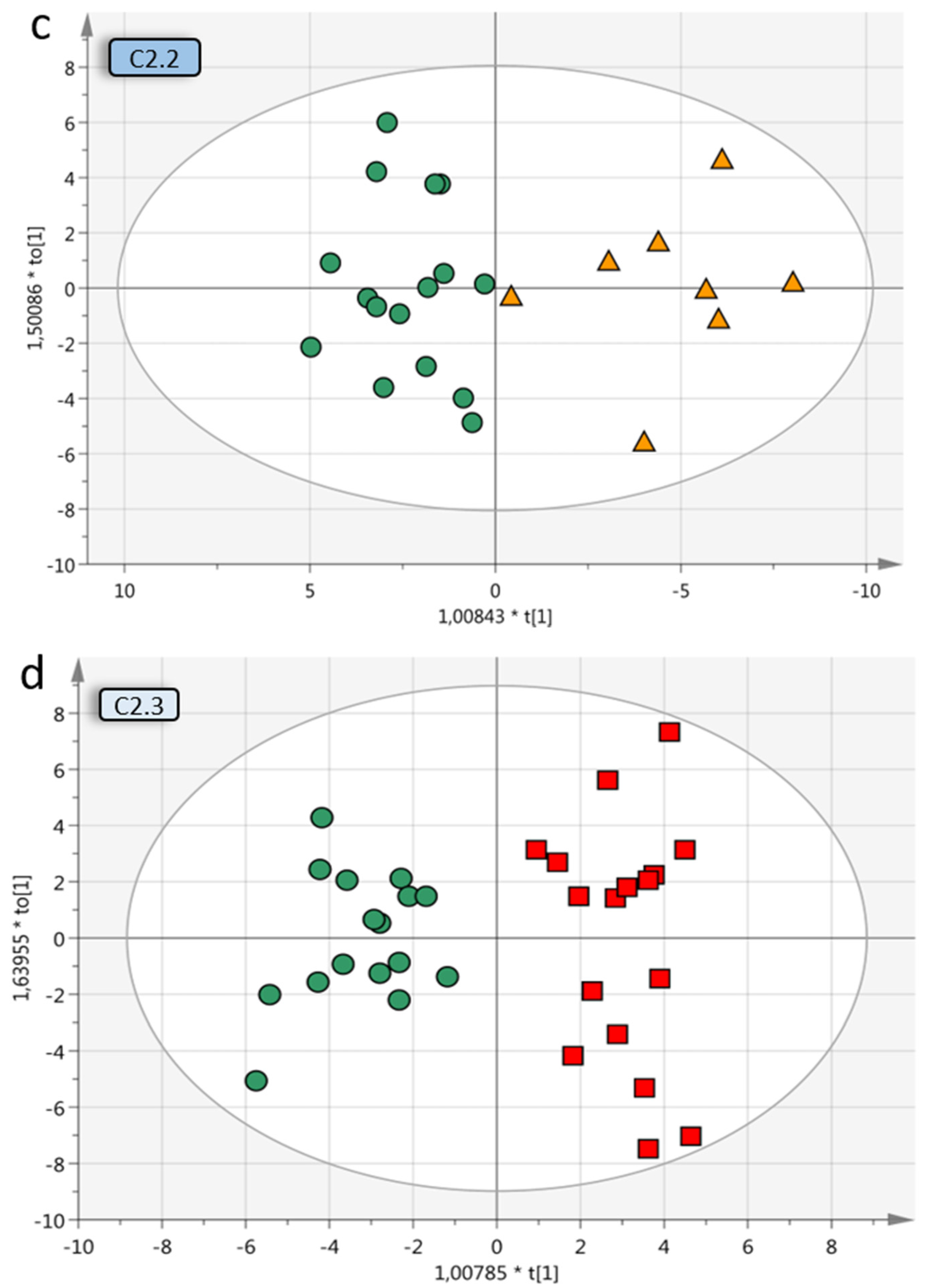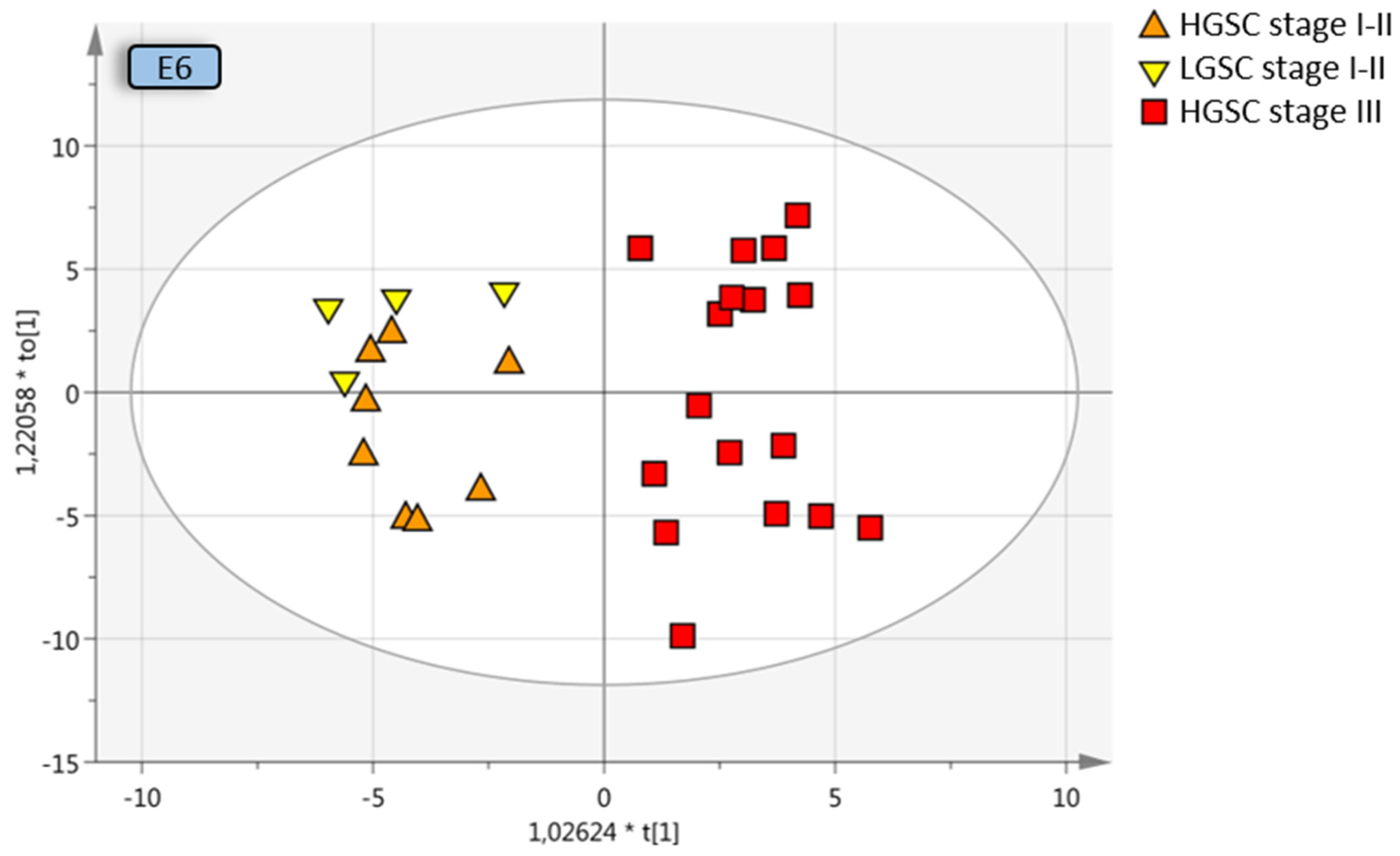Targeted Selected Reaction Monitoring Verifies Histology Specific Peptide Signatures in Epithelial Ovarian Cancer
Abstract
:Simple Summary
Abstract
1. Introduction
2. Materials and Methods
2.1. Study Design—Workflow
2.2. Study Population
2.3. Plasma Sample Preparation
2.4. Selection of Target Peptides and Transitions
2.5. Protein Selection
2.6. Selected Reaction Monitoring Mass Spectrometry
2.7. Multivariate Analyses
2.8. Evaluation of Predictive Value vs. p-Value
3. Results
3.1. Main Results
3.1.1. Histology Specific Peptide Patterns
3.1.2. Multivariate Analysis of the Ovarian Cancer Subgroups
4. Discussion
5. Conclusions
Supplementary Materials
Author Contributions
Funding
Institutional Review Board Statement
Informed Consent Statement
Data Availability Statement
Acknowledgments
Conflicts of Interest
References
- Torre, L.A.; Trabert, B.; DeSantis, C.E.; Miller, K.D.; Samimi, G.; Runowicz, C.D.; Gaudet, M.M.; Jemal, A.; Siegel, R.L. Ovarian cancer statistics, 2018. CA Cancer J. Clin. 2018, 68, 284–296. [Google Scholar] [CrossRef]
- Kurman, R.J.; Shih Ie, M. The origin and pathogenesis of epithelial ovarian cancer: A proposed unifying theory. Am. J. Surg. Pathol. 2010, 34, 433–443. [Google Scholar] [CrossRef] [Green Version]
- Berek, J.S.; Bertelsen, K.; du Bois, A.; Brady, M.F.; Carmichael, J.; Eisenhauer, E.A.; Gore, M.; Grenman, S.; Hamilton, T.C.; Hansen, S.W.; et al. Advanced epithelial ovarian cancer: 1998 consensus statements. Ann. Oncol. 1999, 10, 87–92. [Google Scholar] [CrossRef]
- Pavlik, E.J.; Ueland, F.R.; Miller, R.W.; Ubellacker, J.M.; DeSimone, C.P.; Elder, J.; Hoff, J.; Baldwin, L.; Kryscio, R.J.; van Nagell, J.R., Jr. Frequency and disposition of ovarian abnormalities followed with serial transvaginal ultrasonography. Obstet. Gynecol. 2013, 122, 210–217. [Google Scholar] [CrossRef] [Green Version]
- Jacobs, I.; Oram, D.; Fairbanks, J.; Turner, J.; Frost, C.; Grudzinskas, J.G. A risk of malignancy index incorporating CA 125, ultrasound and menopausal status for the accurate preoperative diagnosis of ovarian cancer. Br. J. Obstet. Gynaecol. 1990, 97, 922–929. [Google Scholar] [CrossRef]
- Lycke, M.; Kristjansdottir, B.; Sundfeldt, K. A multicenter clinical trial validating the performance of HE4, CA125, risk of ovarian malignancy algorithm and risk of malignancy index. Gynecol. Oncol. 2018, 151, 159–165. [Google Scholar] [CrossRef]
- Lycke, M.; Ulfenborg, B.; Kristjansdottir, B.; Sundfeldt, K. Increased diagnostic accuracy of adnexal tumors with a combination of established algorithms and biomarkers. J. Clin. Med. 2020, 9, 299. [Google Scholar] [CrossRef] [Green Version]
- Moore, R.G.; Jabre-Raughley, M.; Brown, A.K.; Robison, K.M.; Miller, M.C.; Allard, W.J.; Kurman, R.J.; Bast, R.C.; Skates, S.J. Comparison of a novel multiple marker assay vs. the Risk of Malignancy Index for the prediction of epithelial ovarian cancer in patients with a pelvic mass. Am. J. Obstet. Gynecol. 2010, 203, 228.e1–228.e6. [Google Scholar] [CrossRef] [Green Version]
- Ueland, F.R.; Desimone, C.P.; Seamon, L.G.; Miller, R.A.; Goodrich, S.; Podzielinski, I.; Sokoll, L.; Smith, A.; van Nagell, J.R., Jr.; Zhang, Z. Effectiveness of a multivariate index assay in the preoperative assessment of ovarian tumors. Obstet. Gynecol. 2011, 117, 1289–1297. [Google Scholar] [CrossRef]
- Kristjansdottir, B.; Levan, K.; Partheen, K.; Carlsohn, E.; Sundfeldt, K. Potential tumor biomarkers identified in ovarian cyst fluid by quantitative proteomic analysis, iTRAQ. Clin. Proteom. 2013, 10, 4. [Google Scholar] [CrossRef] [Green Version]
- Kristjansdottir, B.; Partheen, K.; Fung, E.T.; Marcickiewicz, J.; Yip, C.; Brannstrom, M.; Sundfeldt, K. Ovarian cyst fluid is a rich proteome resource for detection of new tumor biomarkers. Clin. Proteom. 2012, 9, 14. [Google Scholar] [CrossRef] [Green Version]
- Marcisauskas, S.; Ulfenborg, B.; Kristjansdottir, B.; Waldemarson, S.; Sundfeldt, K. Univariate and classification analysis reveals potential diagnostic biomarkers for early stage ovarian cancer Type 1 and Type 2. J. Proteom. 2019, 196, 57–68. [Google Scholar] [CrossRef]
- Waldemarson, S.; Krogh, M.; Alaiya, A.; Kirik, U.; Schedvins, K.; Auer, G.; Hansson, K.M.; Ossola, R.; Aebersold, R.; Lee, H.; et al. Protein expression changes in ovarian cancer during the transition from benign to malignant. J. Proteome Res. 2012, 11, 2876–2889. [Google Scholar] [CrossRef]
- Kristjansdottir, B.; Partheen, K.; Fung, E.T.; Yip, C.; Levan, K.; Sundfeldt, K. Early inflammatory response in epithelial ovarian tumor cyst fluids. Cancer Med. 2014, 3, 1302–1312. [Google Scholar] [CrossRef]
- Poersch, A.; Grassi, M.L.; Carvalho, V.P.; Lanfredi, G.P.; Palma, C.S.; Greene, L.J.; de Sousa, C.B.; Carrara, H.H.A.; Candido Dos Reis, F.J.; Faca, V.M. A proteomic signature of ovarian cancer tumor fluid identified by highthroughput and verified by targeted proteomics. J. Proteom. 2016, 145, 226–236. [Google Scholar] [CrossRef]
- Huttenhain, R.; Surinova, S.; Ossola, R.; Sun, Z.; Campbell, D.; Cerciello, F.; Schiess, R.; Bausch-Fluck, D.; Rosenberger, G.; Chen, J.; et al. N-glycoprotein SRMAtlas: A resource of mass spectrometric assays for N-glycosites enabling consistent and multiplexed protein quantification for clinical applications. Mol. Cell. Proteom. MCP 2013, 12, 1005–1016. [Google Scholar] [CrossRef] [Green Version]
- Kusebauch, U.; Campbell, D.S.; Deutsch, E.W.; Chu, C.S.; Spicer, D.A.; Brusniak, M.Y.; Slagel, J.; Sun, Z.; Stevens, J.; Grimes, B.; et al. Human SRMAtlas: A resource of targeted assays to quantify the complete human proteome. Cell 2016, 166, 766–778. [Google Scholar] [CrossRef] [Green Version]
- Amonkar, S.D.; Bertenshaw, G.P.; Chen, T.H.; Bergstrom, K.J.; Zhao, J.; Seshaiah, P.; Yip, P.; Mansfield, B.C. Development and preliminary evaluation of a multivariate index assay for ovarian cancer. PLoS ONE 2009, 4, e4599. [Google Scholar] [CrossRef] [Green Version]
- Teleman, J.; Waldemarson, S.; Malmstrom, J.; Levander, F. Automated quality control system for LC-SRM setups. J. Proteom. 2013, 95, 77–83. [Google Scholar] [CrossRef]
- MacLean, B.; Tomazela, D.M.; Shulman, N.; Chambers, M.; Finney, G.L.; Frewen, B.; Kern, R.; Tabb, D.L.; Liebler, D.C.; MacCoss, M.J. Skyline: An open source document editor for creating and analyzing targeted proteomics experiments. Bioinformatics 2010, 26, 966–968. [Google Scholar] [CrossRef] [Green Version]
- Teleman, J.; Hauri, S.; Malmstrom, J. Improvements in mass spectrometry assay library generation for targeted proteomics. J. Proteome Res. 2017, 16, 2384–2392. [Google Scholar] [CrossRef]
- Havrilesky, L.J.; Whitehead, C.M.; Rubatt, J.M.; Cheek, R.L.; Groelke, J.; He, Q.; Malinowski, D.P.; Fischer, T.J.; Berchuck, A. Evaluation of biomarker panels for early stage ovarian cancer detection and monitoring for disease recurrence. Gynecol. Oncol. 2008, 110, 374–382. [Google Scholar] [CrossRef]
- Farrah, T.; Deutsch, E.W.; Hoopmann, M.R.; Hallows, J.L.; Sun, Z.; Huang, C.Y.; Moritz, R.L. The state of the human proteome in 2012 as viewed through PeptideAtlas. J. Proteome Res. 2013, 12, 162–171. [Google Scholar] [CrossRef] [Green Version]
- Escher, C.; Reiter, L.; MacLean, B.; Ossola, R.; Herzog, F.; Chilton, J.; MacCoss, M.J.; Rinner, O. Using iRT, a normalized retention time for more targeted measurement of peptides. Proteomics 2012, 12, 1111–1121. [Google Scholar] [CrossRef] [Green Version]
- Teleman, J.; Karlsson, C.; Waldemarson, S.; Hansson, K.; James, P.; Malmstrom, J.; Levander, F. Automated selected reaction monitoring software for accurate label-free protein quantification. J. Proteome Res. 2012, 11, 3766–3773. [Google Scholar] [CrossRef]
- Chawade, A.; Alexandersson, E.; Levander, F. Normalyzer: A tool for rapid evaluation of normalization methods for omics data sets. J. Proteome Res. 2014, 13, 3114–3120. [Google Scholar] [CrossRef]
- Ringner, M. What is principal component analysis? Nat. Biotechnol. 2008, 26, 303–304. [Google Scholar] [CrossRef]
- Bylesjo, M.; Rantalainen, M.; Nicholson, J.K.; Holmes, E.; Trygg, J. K-OPLS package: Kernel-based orthogonal projections to latent structures for prediction and interpretation in feature space. BMC Bioinform. 2008, 9, 106. [Google Scholar] [CrossRef] [Green Version]
- Pierredon, S.; Ribaux, P.; Tille, J.C.; Petignat, P.; Cohen, M. Comparative secretome of ovarian serous carcinoma: Gelsolin in the spotlight. Oncol. Lett. 2017, 13, 4965–4973. [Google Scholar] [CrossRef] [Green Version]
- Wegdam, W.; Argmann, C.A.; Kramer, G.; Vissers, J.P.; Buist, M.R.; Kenter, G.G.; Aerts, J.M.; Meijer, D.; Moerland, P.D. Label-free LC-MSe in tissue and serum reveals protein networks underlying differences between benign and malignant serous ovarian tumors. PLoS ONE 2014, 9, e108046. [Google Scholar] [CrossRef] [Green Version]
- Wentzensen, N.; Poole, E.M.; Trabert, B.; White, E.; Arslan, A.A.; Patel, A.V.; Setiawan, V.W.; Visvanathan, K.; Weiderpass, E.; Adami, H.O.; et al. Ovarian cancer risk factors by histologic subtype: An analysis from the ovarian cancer cohort consortium. J. Clin. Oncol. 2016, 34, 2888–2898. [Google Scholar] [CrossRef]
- Vaughan, S.; Coward, J.I.; Bast, R.C., Jr.; Berchuck, A.; Berek, J.S.; Brenton, J.D.; Coukos, G.; Crum, C.C.; Drapkin, R.; Etemadmoghadam, D.; et al. Rethinking ovarian cancer: Recommendations for improving outcomes. Nat. Rev. Cancer 2011, 11, 719–725. [Google Scholar] [CrossRef] [Green Version]
- Carvalho, V.P.; Grassi, M.L.; Palma, C.S.; Carrara, H.H.A.; Faca, V.M.; Candido Dos Reis, F.J.; Poersch, A. The contribution and perspectives of proteomics to uncover ovarian cancer tumor markers. Transl. Res. 2019, 206, 71–90. [Google Scholar] [CrossRef]
- Bradbury, M.; Borras, E.; Perez-Benavente, A.; Gil-Moreno, A.; Santamaria, A.; Sabido, E. Proteomic studies on the management of high-grade serous ovarian cancer patients: A mini-review. Cancers 2021, 13, 2067. [Google Scholar] [CrossRef]
- Cancer Genome Atlas Research Network. Integrated genomic analyses of ovarian carcinoma. Nature 2011, 474, 609–615. [Google Scholar] [CrossRef]
- Zhang, H.; Liu, T.; Zhang, Z.; Payne, S.H.; Zhang, B.; McDermott, J.E.; Zhou, J.Y.; Petyuk, V.A.; Chen, L.; Ray, D.; et al. Integrated proteogenomic characterization of human high-grade serous ovarian cancer. Cell 2016, 166, 755–765. [Google Scholar] [CrossRef] [Green Version]
- Coscia, F.; Watters, K.M.; Curtis, M.; Eckert, M.A.; Chiang, C.Y.; Tyanova, S.; Montag, A.; Lastra, R.R.; Lengyel, E.; Mann, M. Integrative proteomic profiling of ovarian cancer cell lines reveals precursor cell associated proteins and functional status. Nat. Commun. 2016, 7, 12645. [Google Scholar] [CrossRef]
- Hughes, C.S.; McConechy, M.K.; Cochrane, D.R.; Nazeran, T.; Karnezis, A.N.; Huntsman, D.G.; Morin, G.B. Quantitative profiling of single formalin fixed tumour sections: Proteomics for translational research. Sci. Rep. 2016, 6, 34949. [Google Scholar] [CrossRef]
- Dieters-Castator, D.Z.; Rambau, P.F.; Kelemen, L.E.; Siegers, G.M.; Lajoie, G.A.; Postovit, L.M.; Kobel, M. Proteomics-derived biomarker panel improves diagnostic precision to classify endometrioid and high-grade serous ovarian carcinoma. Clin. Cancer Off. J. Am. Assoc. Cancer Res. 2019, 25, 4309–4319. [Google Scholar] [CrossRef] [Green Version]
- Martinez-Garcia, E.; Lesur, A.; Devis, L.; Campos, A.; Cabrera, S.; van Oostrum, J.; Matias-Guiu, X.; Gil-Moreno, A.; Reventos, J.; Colas, E.; et al. Development of a sequential workflow based on LC-PRM for the verification of endometrial cancer protein biomarkers in uterine aspirate samples. Oncotarget 2016, 7, 53102–53115. [Google Scholar] [CrossRef] [Green Version]






| Histology | n | Grade 1 | Stage 1 | Mean Age (Years) | SD Age (Years) |
|---|---|---|---|---|---|
| Serous benign | 16 | N/A | N/A | 69 | 8.7 |
| Serous borderline | 13 | N/A | I | 51.7 | 18.4 |
| LGSC | 4 | low | I–II | 52.3 | 5.7 |
| Mucinous | 9 | low | I–II | 67.3 | 7.3 |
| Endometrioid 2 | 3 | low | I–II | 76.3 | 9.1 |
| Endometrioid 2 | 4 | high | I–II | 59 | 16.2 |
| HGSC | 8 | high | I–II | 59.3 | 5.1 |
| HGSC | 17 | high | III | 61.5 | 12.1 |
| Benign vs. Subgroup | n | OPLS-DA Model-Name (also Figure 2a) | Q2, VIP > 1.0 | #Peptides VIP > 1.0 Unique 1 Peptides | #Peptides p < 0.05 (% Shared with VIP > 1)Unique 2 Peptides |
|---|---|---|---|---|---|
| All malignant incl. Borderline | 74 | A1 | 0.138 | 63 | 30, q = 0.26 |
| All malignant excl. Borderline | 61 | A2 | 0.226 | 61 | 41, q = 0.184 |
| Low-grade 1 incl. Borderline | 45 | B1 | 0.221 | 63 | 22, q = 0.298 |
| Low-grade 1 excl. Borderline | 33 | B2 | 0.624 | 59 | 37, q = 0.219 |
| Borderline type tumor | 29 | B2.4 | 0.247 | 65, 1 0 | 11 (45%) 2 6 q = 0.688 |
| Stage I–II (all histologies) | 44 | E1 (B2 + C1.1 + C2.2) | 0.369 | 66 | 39, q = 0.194 |
| Endometrioid stage I–II | 20 | B2.1/C1.1 | 0.428 | 61, 1 5 | 17 (100%) 2 5 q = 0.447 |
| Mucinous stage I–II | 25 | B2.2 | 0.611 | 77, 1 8 | 41 (95%) 2 9 q = 0.190 |
| LGSC stage I–II | 20 | B2.3 | 0.615 | 63, 1 15 | 11 (100%) 2 5 q = 0.567 |
| High-grade 1 | 45 | C1 | 0.333 | 55 | 33, q = 0.234 |
| HGSC stage I–III | 41 | C2 | 0.375 | 59 | 42, q = 0.193 |
| HGSC stage I–II | 24 | C2.2 | 0.513 | 62, 1 9 | 34 (94%) 2 9 q = 0.206 |
| HGSC stage III | 33 | C2.3 | 0.43 | 65, 1 8 | 39 (95%) 2 12 q = 0.212 |
| Subgroups in Comparison | n | OPLS-DA Model | Q2, VIP > 1.0 | #Peptides VIP > 1.0 | #Peptides p < 0.05 |
|---|---|---|---|---|---|
| LGSC stage I–II vs. Mucinous stage I–II | 13 | D1 | 0.468 | 71 | 25, q = 0.313 |
| Endometrioid stage I–II vs. Mucinous stage I–II | 16 | D2 | 0.356 | 69 | 14, q = 0.465 |
| Endometrioid stage I–II vs. LGSC stage I–II | 11 | D3 | 0.654 | 66 | 7, q = 0.761 |
| LGSC stage I–II vs. HGSC stage I–II | 12 | D4 | 0.41 | 72 | 9, q = 0.569 |
| Endometrioid 1 stage I–II vs. HGSC stage I–II | 15 | D5 | 0.354 | 70 | 9, q = 0.579 |
| Mucinous stage I–II vs. HGSC stage I–II | 17 | D6 | 0.356 | 63 | 17, q = 0.436 |
| LGSC stage I–II vs. HGSC stage III | 21 | D7 | 0.634 | 65 | 25, q = 0.302 |
| Endometrioid 1 stage I–II vs. HGSC stage III | 24 | D8 | 0.388 | 61 | 25, q = 0.33 |
| Mucinous stage I–II vs. HGSC stage III | 26 | D9 | 0.379 | 60 | 10, q = 0.658 |
| HGSC stage I–II vs. HGSC stage III | 25 | D10 | 0.592 | 66 | 18, q = 0.404 |
| Low-grade incl. Borderline vs. High-grade | 58 | E4 | 0.175 | 57 | 24, q = 0.329 |
| Low-grade vs. High-grade | 45 | E5 | 0.356 | 63 | 16, q = 0.489 |
| LGSC and HGSC stage I–II vs. HGSC stage III | 29 | E6 | 0.612 | 69 | 34, q = 0.241 |
| All stage I–II incl. borderline vs. stage III | 58 | E7 | 0.374 | 60 | 47, q = 0.168 |
| All stage I–II vs. stage III | 45 | E8 | 0.299 | 57 | 29, q = 0.272 |
Publisher’s Note: MDPI stays neutral with regard to jurisdictional claims in published maps and institutional affiliations. |
© 2021 by the authors. Licensee MDPI, Basel, Switzerland. This article is an open access article distributed under the terms and conditions of the Creative Commons Attribution (CC BY) license (https://creativecommons.org/licenses/by/4.0/).
Share and Cite
Liljedahl, L.; Malmström, J.; Kristjansdottir, B.; Waldemarson, S.; Sundfeldt, K. Targeted Selected Reaction Monitoring Verifies Histology Specific Peptide Signatures in Epithelial Ovarian Cancer. Cancers 2021, 13, 5713. https://doi.org/10.3390/cancers13225713
Liljedahl L, Malmström J, Kristjansdottir B, Waldemarson S, Sundfeldt K. Targeted Selected Reaction Monitoring Verifies Histology Specific Peptide Signatures in Epithelial Ovarian Cancer. Cancers. 2021; 13(22):5713. https://doi.org/10.3390/cancers13225713
Chicago/Turabian StyleLiljedahl, Leena, Johan Malmström, Björg Kristjansdottir, Sofia Waldemarson, and Karin Sundfeldt. 2021. "Targeted Selected Reaction Monitoring Verifies Histology Specific Peptide Signatures in Epithelial Ovarian Cancer" Cancers 13, no. 22: 5713. https://doi.org/10.3390/cancers13225713
APA StyleLiljedahl, L., Malmström, J., Kristjansdottir, B., Waldemarson, S., & Sundfeldt, K. (2021). Targeted Selected Reaction Monitoring Verifies Histology Specific Peptide Signatures in Epithelial Ovarian Cancer. Cancers, 13(22), 5713. https://doi.org/10.3390/cancers13225713






